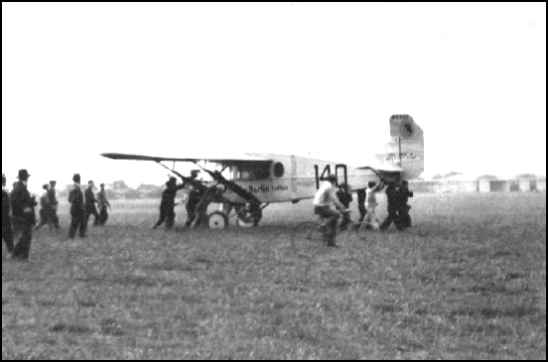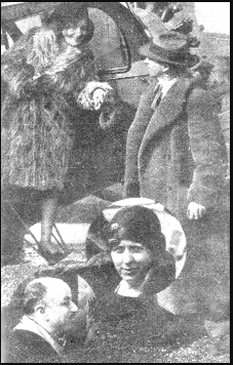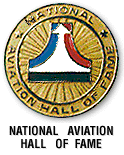
1893-1976 |
 |
Collection of Tim Gould, 5-31-06 |
 |
| Col. Chamberlin's "Miss Columbia", first plane to fly the Atlantic with a passenger - New York-Berlin, June 4, 5 and 6th, 1927 - 3927 miles in 43 hours, 31 minutes. Col. Chamberlin is now manufacturing planes and war material and training thousands of men and women for top pay Victory jobs. |
 |
Collection of Timothy J. Gould Gould Auction Company 947 Village Rd. Smithfield, ME 04978 Phone -362-6045 5-31-06 |
|
via email from Tim Gould, 5-31-06 A GREAT website indeed!! Thanks for your efforts!! I am attaching a photo of Clarence Chamberlin (I have several others) that is amongst a wonderful Chamberlin collection that we will be selling in our next auction (date yet to be determined) here at Gould Auction Company. Our website is www.gouldauctions.com. You are welcome to use this photo on your website and please keep watch for more photos of Chamberlin along with several items that were presented to him upon the completion of his famous flight. Included in the collection is a very large German (.800 silver) bowl presented to him by the German government inscribed "Dem Bezwinger des Ozeans.....Herrn Chamberlin... ...ihrem ehrenburger.....zum Andenken andie Landung...bei Cottbus am 6 Junis 1927....gewidmet bonder Stadt Cottbus" (could you translate this???). A Sterling silver pin presented to him by the Austrian Aviators Association inscribed "Presented with Highest Esteem to the Conqueror of the Air"; a 1927 bronze medal presented by the German government comemmorating his flight; a Sterling silver plate presented to him by Air Associates in 1959 and other jewelry. The photos are superb so please look for them on our website in the next few days and weeks. Please find a neat postcard included in the collection with a hand written message from Chamberlin on the back. Thanks again for your fine website.....we enjoyed the history lesson thoroughly. Best regards, Tim Gould |
 |
|
Photo Courtesy of Roy Nagl Ancient Aviators Website |
|
E. P. Dutton, 1979 |
 |
|
Photo Courtesy of Roy Nagl Ancient Aviators Website |
via email from Louis Keefer, 11-3-05 When I was ten or possibly eleven years old. living in Wheeling, WV, my father took me over to the grass field at Yorkville, OH, just across the Ohio River from Warwood, a northern suburb of Wheeling, to take my first-ever airplane ride with the famed Clarence Chamberlin in one of the two Curtiss Condors he had bought used from Eastern Airlines when they were phased out.This would have been either in 1935 or 1936. As I understand it he barnstormed the USA offering rides to one and all for $5 a shot; he is alleged to have given their first airplane rides to more people than any other man in history. I remember that old Condor fairly well. It had biplane stabilizers and twin rudders mounted in a box-like arrangement. Twin engine biplane, carried about 12-15 passengers I think. On takeoff we sort of angled out over the Ohio River and with each little bump I felt like oh-my-god the wings are going to fall off. We flew south 7 or 8 miles, did a shallow figure-eight over downtown Wheeling, flew back and landed. Maybe fifteen minutes altogether. My dad gave me the window seat and to see the city far below me was a thrill I've never forgotten. Needless to say, I was hooked on aviation forever. By the way, my last book was titled, From Maine to Mexico: With America's Private Pilots in the Fight Against Nazi UBoats. I don't have any left for sale or giveaway, but you can find a copy for reading through your local library. A few of the pilots I interviewed may have been Early Birds. In any case I think you'd enjoy reading about the old Wacos and Fairchilds and Stinsons they used to patrol our coastal waters in 1942-43.. All the best. Louis |
Clarence Chamberlin: The man who would be Lindbergh by Ken Brooks To read the rest of this article, which the author, Ken Brooks, has graciously shared with us, click in the title above. |
|
gives No. 2 aviator P.C. link Unfortunately, today, (11-4-05), as I was updating the Chamberlin webpage, I discovered that the link had become obsolete. Luckily, I had made a copy of the original article and you may still enjoy it by clicking on the title above. |
|
via email from Jim Wilson, 8-26-06 Now, fast forward to about 1938. My father had lost his job with the construction company and had found another one. We were living in Baltimore. There was an article in the paper about Chamberlin coming to the airport and rides would be available. My dad remembered him and we went there. Mom, dad, me, now about nine and my sister about 3. My dad bought tickets for me and my mother. He held my sister and stayed on the ground. The plane was not the one that he flew the Atlantic in, but was a multi-engine with Amoco painted on the side. It held maybe a dozen passengers. While my mother and I were in the plane waiting for Chamberlin to board, an announcement was made on the loudspeaker. We were told that Chamberlin would be delayed because he had met an old acquaintance from Warsaw. That was my dad. They talked for a few minutes. When Chamberlin walked past us my mother told him that it was her husband he was talking to and I think he gave us a longer than normal flight. The flight was exciting. I remember very well watching the exhaust pipes turn every color of the spectrum, in fact I remember that better than the scenery. The plane was a horrible old crate with wires going every which way holding things together. Just thought I'd add to the store of knowledge on Chamberlin. Jim Wilson Editor's Note: I am so very grateful to Jim for sharing his memories with us. I just love to receive stories such as this and add them to the pages of the pioneers. |
|
SUPPLEMENT via email from Jim Wilson, 8-29-06 Another story not related to Chamberlin is that my father flew commercial from Warsaw to Prague and back one time in about 1926. My sister now has the postcard with a picture of the plane. The pilot sat outside in a cockpit, behind a windshield. The passengers were inside. My father wrote to his mother in Brooklyn about the flight. He said that it was a great way to travel and was the way it was going to be in the future. He said that he got to sit outside with the pilot for a while too. The plane went about 90 miles per hour. Jim Wilson |
Journey From New York, Here |
 |
|
Clarence D. Chamberlin, famous Atlantic flyer, aiding Lee Clark, New York showgirl, from the cabin of his Crescent monoplane, following their arrival at the Buffalo Airport Saturday afternoon. Below are Michael Gregor, Russian Plane designer and Mary Ellen Tremaine, "fly- ing schoolma'm," who also accompanied Chamberlin on his cross-state flight. |
|
One of America's greatest fliers, who flew a single-motored monoplane from New York far into
Germany, was a visitor in Buffalo Saturday. It was Clarence D. Chamberlin. Chamberlin dropped on the Buffalo Airport runways at 3:40 p. m. to make a hurried visit to the Buffalo aviation show in Broadway auditorium and to spend a few moments with Major R. H. Fleet, president of the Consolidated Aircraft corporation, who invited the intrepid flyer to Buffalo. Possibilities were that Chamberlin would negotiate with Major Fleet for the purchase of several Consolidated modesl for use in his contemplated training schools. He was accompanied on his cross-state flight Saturday by Michael Gregor, famous Russian aviator and his chief assistant; Mary Ellen Tremaine, flying "school ma'am," of East Orange, N. J., and Lee Clark, New York show girl. The party traveled in a Crescent monoplane, powered with a 300-horsepower Wright J-6 motor. The craft was designed by Gregor and built in Chamberlin's factory in New York. Chamberlin has been flying all over the Eastern states during the last few weeks in the interests of his proposed string of flying schools, the first of which opened in Norfolk,k Va., recently. Thursday he flew from New York to Washington personally to invite President and Mrs. Hoover to attend the Aviation ball in New York. Friday he delivered a new Crescent plane to a Philadelphia training school. |
|
|
 |
To visit his entry on this site, first click on National Aviation Hall of Fame to go to the homepage. Next, highlight and click on "Enshrinees List" at the lower left corner of the page. You will find an alphabetical listing of all enshrinees on this page. Then highlight and click on his name. |
|
The saga of the first transatlantic air passenger By Herb Geduld |
|
"All I can say is that I think it is the same plane that I rode in. I remember all the wires between the wings. We were sitting near the forward of the center and that is where I watched the exhaust pipes as they turned different colors. Frankly, it did not give the feeling of a very safe airplane and I doubt if today anything like that would be approved for passengers. The other thing is that in all I have read, I see no reference to his "escape" from Berlin and his flight to Warsaw. Glad to hear my info was of interest to you. Jim Wilson " You can see a photo of the plane by clicking on the title above. In addition, you will find a very comprehensive biography of Clarence on the page. Included is a brief mention of his experiences in Germany. |
|
You may want to use the "Find" function on "Chamberlin" |
|
|


|